Vegetation Change and Conservation Evaluation of the Cangshan Erhai National Nature Reserve (Cangshan Mountain Part) in Southwest China
Abstract
1. Introduction
2. Materials and Methods
2.1. Study Area
2.2. Data Sources
2.3. Methods
2.3.1. Vegetation Extraction and Pattern Analysis
2.3.2. Fractional of Vegetation Coverage and Change Analysis
3. Results and Discussion
3.1. Vegetation Composition and Changes in the Cangshan Mountain
3.2. Vegetation Configuration and Changes in the Cangshan Mountain
3.3. FVC and Changes in the Cangshan Mountain
3.4. Impacts of Conservation Management on Vegetation Changes in the Cangshan Mountain
4. Conclusions
Author Contributions
Funding
Data Availability Statement
Acknowledgments
Conflicts of Interest
References
- Hussain, S.; Qin, S.; Nasim, W.; Bukhari, M.A.; Mubeen, M.; Fahad, S.; Raza, A.; Abdo, H.G.; Tariq, A.; Mousa, B.J.A. Monitoring the dynamic changes in vegetation cover using spatio-temporal remote sensing data from 1984 to 2020. Atmosphere 2022, 13, 1609. [Google Scholar] [CrossRef]
- Chen, T.; Guo, R.; Yan, Q.; Chen, X.; Zhou, S.; Liang, C.; Wei, X.; Dolman, H.J.B. Land management contributes significantly to observed vegetation browning in Syria during 2001–2018. Biogeosciences 2022, 19, 1515–1525. [Google Scholar] [CrossRef]
- Aly, A.A.; Al-Omran, A.M.; Sallam, A.S.; Al-Wabel, M.I.; Al-Shayaa, M.S.J.S.E. Vegetation cover change detection and assessment in arid environment using multi-temporal remote sensing images and ecosystem management approach. Solid Earth 2016, 7, 713–725. [Google Scholar] [CrossRef]
- Peng, L.; Deng, W.; Ying, L. Understanding the Role of Urbanization on Vegetation Dynamics in Mountainous Areas of Southwest China: Mechanism, Spatiotemporal Pattern, and Policy Implications. ISPRS Int. J. Geo-Inf. 2021, 10, 590. [Google Scholar] [CrossRef]
- Bai, Y.; Li, S.; Liu, M.; Guo, Q. Assessment of vegetation change on the Mongolian Plateau over three decades using different remote sensing products. J. Environ. Manag. 2022, 317, 115509. [Google Scholar] [CrossRef]
- Piedallu, C.; Cheret, V.; Denux, J.-P.; Perez, V.; Azcona, J.S.; Seynave, I.; Gégout, J. Soil and climate differently impact NDVI patterns according to the season and the stand type. Sci. Total Environ. 2019, 651, 2874–2885. [Google Scholar] [CrossRef] [PubMed]
- Piao, S.; Wang, X.; Park, T.; Chen, C.; Lian, X.; He, Y.; Bjerke, J.W.; Chen, A.; Ciais, P.; Tømmervik, H.; et al. Characteristics, drivers and feedbacks of global greening. Nat. Rev. Earth Environ. 2020, 1, 14–27. [Google Scholar] [CrossRef]
- Geldmann, J.; Manica, A.; Burgess, N.D.; Coad, L.; Balmford, A. A global-level assessment of the effectiveness of protected areas at resisting anthropogenic pressures. Proc. Natl. Acad. Sci. USA 2019, 116, 23209–23215. [Google Scholar] [CrossRef]
- Huang, S.; Zheng, X.; Ma, L.; Wang, H.; Huang, Q.; Leng, G.; Meng, E.; Guo, Y. Quantitative contribution of climate change and human activities to vegetation cover variations based on GA-SVM model. J. Hydrol. 2020, 584, 124687. [Google Scholar] [CrossRef]
- Gao, X.; Huang, X.; Lo, K.; Dang, Q.; Wen, R. Vegetation responses to climate change in the Qilian Mountain Nature Reserve, Northwest China. Glob. Ecol. Conserv. 2021, 28, e01698. [Google Scholar] [CrossRef]
- Strubelt, I.; Diekmann, M.; Peppler-Lisbach, C.; Gerken, A.; Zacharias, D. Vegetation changes in the Hasbruch forest nature reserve (NW Germany) depend on management and habitat type. For. Ecol. Manag. 2019, 444, 78–88. [Google Scholar] [CrossRef]
- Zhang, Y.-X.; Wang, Y.-K.; Fu, B.; Dixit, A.M.; Chaudhary, S.; Wang, S. Impact of climatic factors on vegetation dynamics in the upper Yangtze River basin in China. J. Mt. Sci. 2020, 17, 1235–1250. [Google Scholar] [CrossRef]
- Haight, J.; Hammill, E. Protected areas as potential refugia for biodiversity under climatic change. Biol. Conserv. 2020, 241, 108258. [Google Scholar] [CrossRef]
- Sun, S.; Sang, W.; Axmacher, J.C. China’s national nature reserve network shows great imbalances in conserving the country’s mega-diverse vegetation. Sci. Total Environ. 2020, 717, 137159. [Google Scholar] [CrossRef]
- Qian, D.; Cao, G.; Du, Y.; Li, Q.; Guo, X. Impacts of climate change and human factors on land cover change in inland mountain protected areas: A case study of the Qilian Mountain National Nature Reserve in China. Environ. Monit. Assess. 2019, 191, 486. [Google Scholar] [CrossRef] [PubMed]
- Liu, Y.; Wang, C.; Wang, H.; Chang, Y.; Yang, X.; Zang, F.; Liu, X.; Zhao, C. An integrated ecological security early-warning framework in the national nature reserve based on the gray model. J. Nat. Conserv. 2023, 73, 126394. [Google Scholar] [CrossRef]
- Becker, T.; Spanka, J.; Schröder, L.; Leuschner, C. Forty years of vegetation change in former coppice-with-standards woodlands as a result of management change and N deposition. Appl. Veg. Sci. 2017, 20, 304–313. [Google Scholar] [CrossRef]
- Piao, S.; Yin, G.; Tan, J.; Cheng, L.; Huang, M.; Li, Y.; Liu, R.; Mao, J.; Myneni, R.B.; Peng, S. Detection and attribution of vegetation greening trend in China over the last 30 years. Glob. Chang. Biol. 2015, 21, 1601–1609. [Google Scholar] [CrossRef]
- Pan, N.; Feng, X.; Fu, B.; Wang, S.; Ji, F.; Pan, S. Increasing global vegetation browning hidden in overall vegetation greening: Insights from time-varying trends. Remote Sens. Environ. 2018, 214, 59–72. [Google Scholar] [CrossRef]
- Huang, L.; Shao, Q.; Liu, J. Assessing the conservation effects of nature reserve networks under climate variability over the northeastern Tibetan plateau. Ecol. Indic. 2019, 96, 163–173. [Google Scholar] [CrossRef]
- Tang, J.; Lu, H.; Xue, Y.; Li, J.; Li, G.; Mao, Y.; Deng, C.; Li, D. Data-driven planning adjustments of the functional zoning of Houhe National Nature Reserve. Glob. Ecol. Conserv. 2021, 29, e01708. [Google Scholar] [CrossRef]
- Yang, J.; Cui, Z.; Yi, C.; Sun, J.; Yang, L. “Tali Glaciation” on Massif Diancang. Sci. China Ser. D Earth Sci. 2007, 50, 1685–1692. [Google Scholar] [CrossRef]
- Li, Z.; Duan, X. Comparative Evaluation of Geological Heritage Landscapes in Dali-Cangshan Global Geopark. Chin. J. Urban Environ. Stud. 2022, 10, 2250021. [Google Scholar] [CrossRef]
- He, F.; Wu, N.; Dong, X.; Tang, T.; Domisch, S.; Cai, Q.; Jähnig, S.C. Elevation, aspect, and local environment jointly determine diatom and macroinvertebrate diversity in the Cangshan Mountain, Southwest China. Ecol. Indic. 2020, 108, 105618. [Google Scholar] [CrossRef]
- Zeng, Y.; Hao, D.; Huete, A.; Dechant, B.; Berry, J.; Chen, J.M.; Joiner, J.; Frankenberg, C.; Bond-Lamberty, B.; Ryu, Y.; et al. Optical vegetation indices for monitoring terrestrial ecosystems globally. Nat. Rev. Earth Environ. 2022, 3, 477–493. [Google Scholar] [CrossRef]
- De Simone, L.; Navarro, D.; Gennari, P.; Pekkarinen, A.; de Lamo, J. Using standardized time series land cover maps to monitor the sdg indicator “mountain green cover index” and assess its sensitivity to vegetation dynamics. ISPRS Int. J. Geo-Inf. 2021, 10, 427. [Google Scholar] [CrossRef]
- Xie, Z.; Phinn, S.R.; Game, E.T.; Pannell, D.J.; Hobbs, R.J.; Briggs, P.R.; McDonald-Madden, E. Using Landsat observations (1988–2017) and Google Earth Engine to detect vegetation cover changes in rangelands—A first step towards identifying degraded lands for conservation. Remote Sens. Environ. 2019, 232, 111317. [Google Scholar] [CrossRef]
- Nitze, I.; Grosse, G. Detection of landscape dynamics in the Arctic Lena Delta with temporally dense Landsat time-series stacks. Remote Sens. Environ. 2016, 181, 27–41. [Google Scholar] [CrossRef]
- Yang, H.; Yang, X.; Heskel, M.; Sun, S.; Tang, J. Seasonal variations of leaf and canopy properties tracked by ground-based NDVI imagery in a temperate forest. Sci. Rep. 2017, 7, 1267. [Google Scholar] [CrossRef]
- Fichera, C.R.; Modica, G.; Pollino, M. Land Cover classification and change-detection analysis using multi-temporal remote sensed imagery and landscape metrics. Eur. J. Remote Sens. 2012, 45, 1–18. [Google Scholar] [CrossRef]
- McGarigal, K. FRAGSTATS: Spatial Pattern Analysis Program for Quantifying Landscape Structure; US Department of Agriculture, Forest Service, Pacific Northwest Research Station: Portland, OR, USA, 1995; Volume 351.
- Zhang, S.; Chen, H.; Fu, Y.; Niu, H.; Yang, Y.; Zhang, B. Fractional Vegetation Cover Estimation of Different Vegetation Types in the Qaidam Basin. Sustainability 2019, 11, 864. [Google Scholar] [CrossRef]
- Chen, Y.; Hu, X.; Zhang, Y.; Feng, J. Characterizing the Long-Term Landscape Dynamics of a Typical Cloudy Mountainous Area in Northwest Yunnan, China. Sustainability 2022, 14, 13488. [Google Scholar] [CrossRef]
- Qiu, S.; He, B.; Zhu, Z.; Liao, Z.; Quan, X. Improving Fmask cloud and cloud shadow detection in mountainous area for Landsats 4–8 images. Remote Sens. Environ. 2017, 199, 107–119. [Google Scholar] [CrossRef]
- Tao, Y.; Zhang, W.; Duan, C.; Chen, Y.; Ren, J.; Xing, D.; He, Q. Climatic causes of continuous drought over Yunnan Province from 2009 to 2012. J. Yunnan Univ. Nat. Sci. Ed. 2014, 36, 866–874. [Google Scholar] [CrossRef]
- Jin, Y.; Kuang, X.; Yan, H.; Wan, Y.; Wang, P. Studies on Distribution Characteristics and Variation Trend of the Regional Drought Events over Yunnan in Recent 55 Years. Meteorol. Mon. 2018, 44, 1169–1178. [Google Scholar] [CrossRef]
- Wang, P.; Cheng, Q.; Jin, H. Divergent vegetation variation and the response to extreme climate events in the National Nature Reserves in Southwest China, 1961–2019. Ecol. Indic. 2023, 150, 110247. [Google Scholar] [CrossRef]
- Xia, J.; Cao, M.; Xiao, W.; Li, Y.; Fu, G.; Wang, W.; Li, J. Integrating Spatial Valuation of Ecosystem Services into Protected Area Management: A Case Study of the Cangshan Nature Reserve in Dali, China. Sustainability 2020, 12, 9395. [Google Scholar] [CrossRef]
- Tang, M.; Qiu, S.; Liu, L.; Li, T.; Li, S.; Yu, T. Landscape influences and management countermeasures of ginseng planting near Changbai mountain nature reserve. J. For. Res. 2022, 33, 1939–1948. [Google Scholar] [CrossRef]
- Zhang, Y.; Yin, H.; Zhu, L.; Miao, C. Landscape Fragmentation in Qinling–Daba Mountains Nature Reserves and Its Influencing Factors. Land 2021, 10, 1124. [Google Scholar] [CrossRef]
- Sun, Q.; Liu, W.; Gao, Y.; Li, J.; Yang, C. Spatiotemporal variation and climate influence factors of vegetation ecological quality in the sanjiangyuan national park. Sustainability 2020, 12, 6634. [Google Scholar] [CrossRef]
- Gallardo, B.; Aldridge, D.C.; González-Moreno, P.; Pergl, J.; Pizarro, M.; Pyšek, P.; Thuiller, W.; Yesson, C.; Vilà, M. Protected areas offer refuge from invasive species spreading under climate change. Glob. Chang. Biol. 2017, 23, 5331–5343. [Google Scholar] [CrossRef] [PubMed]
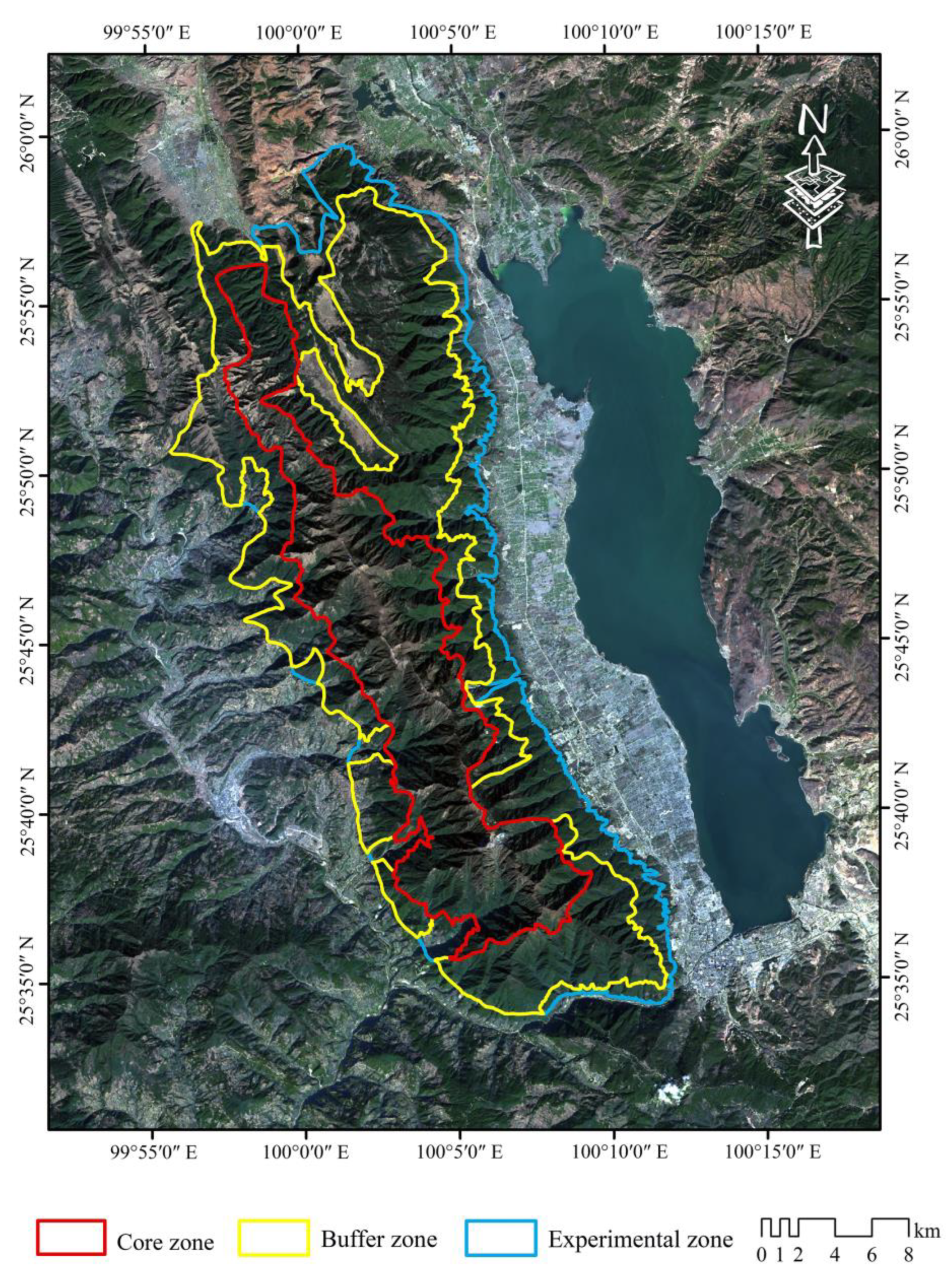
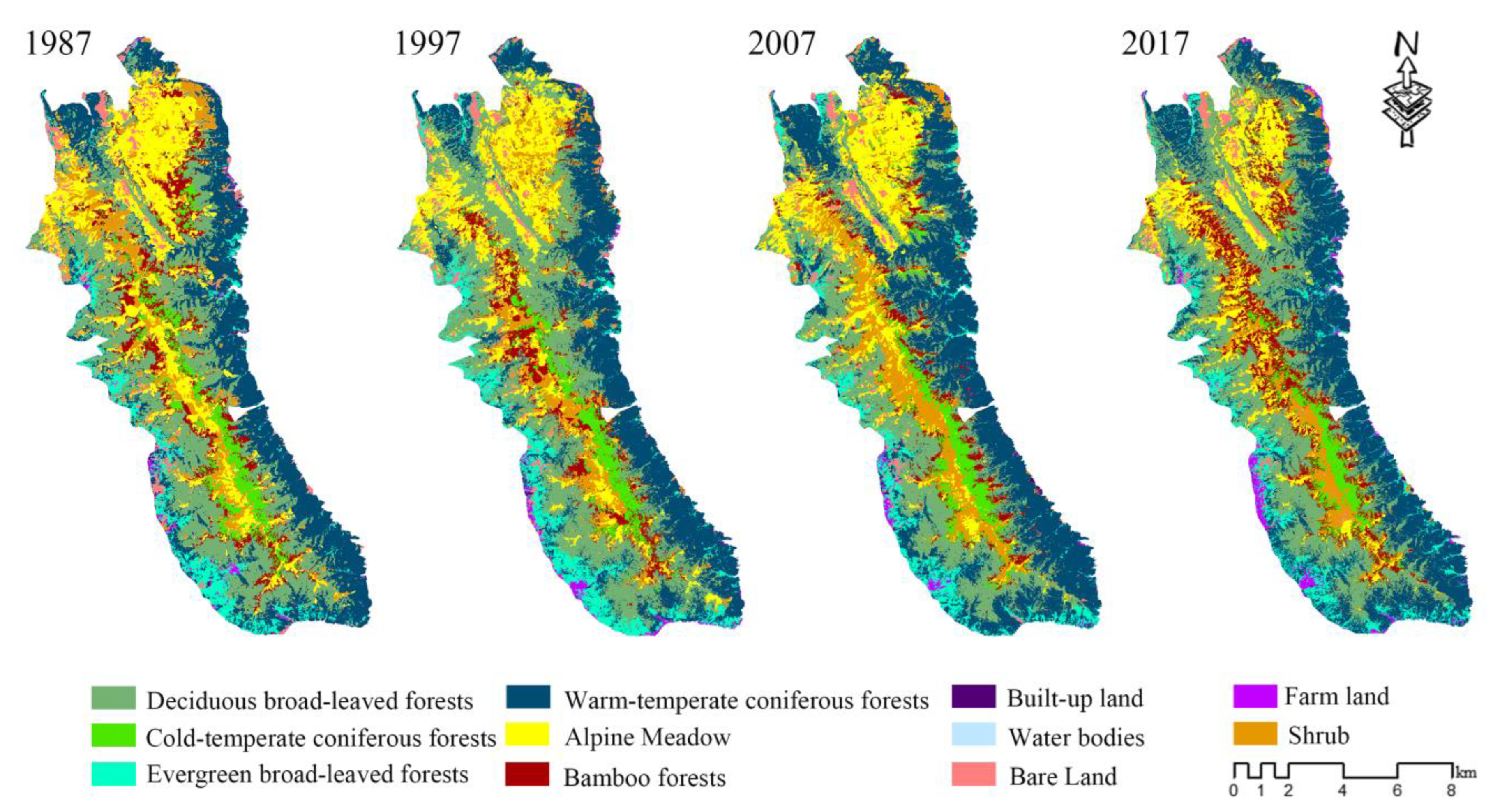
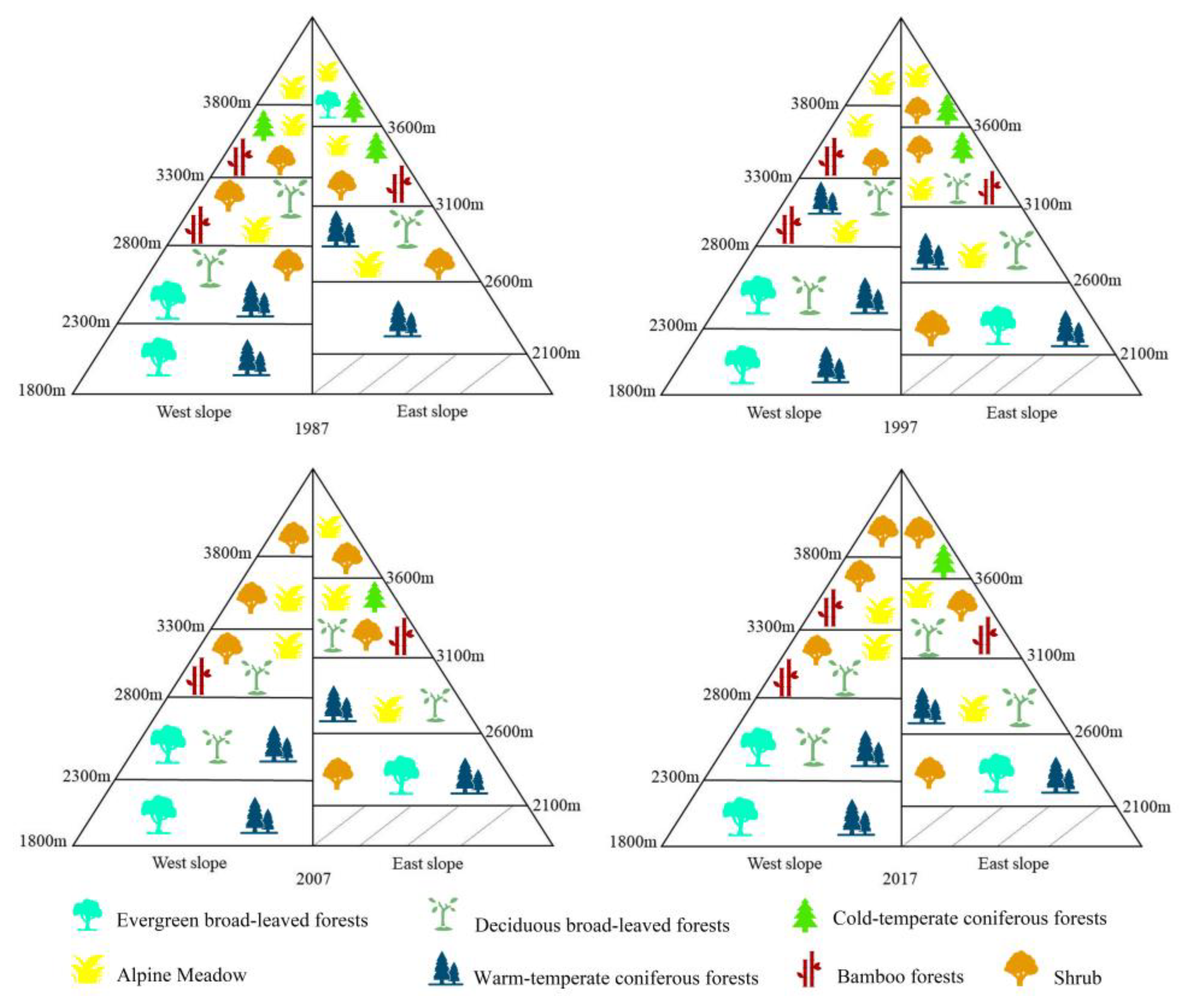
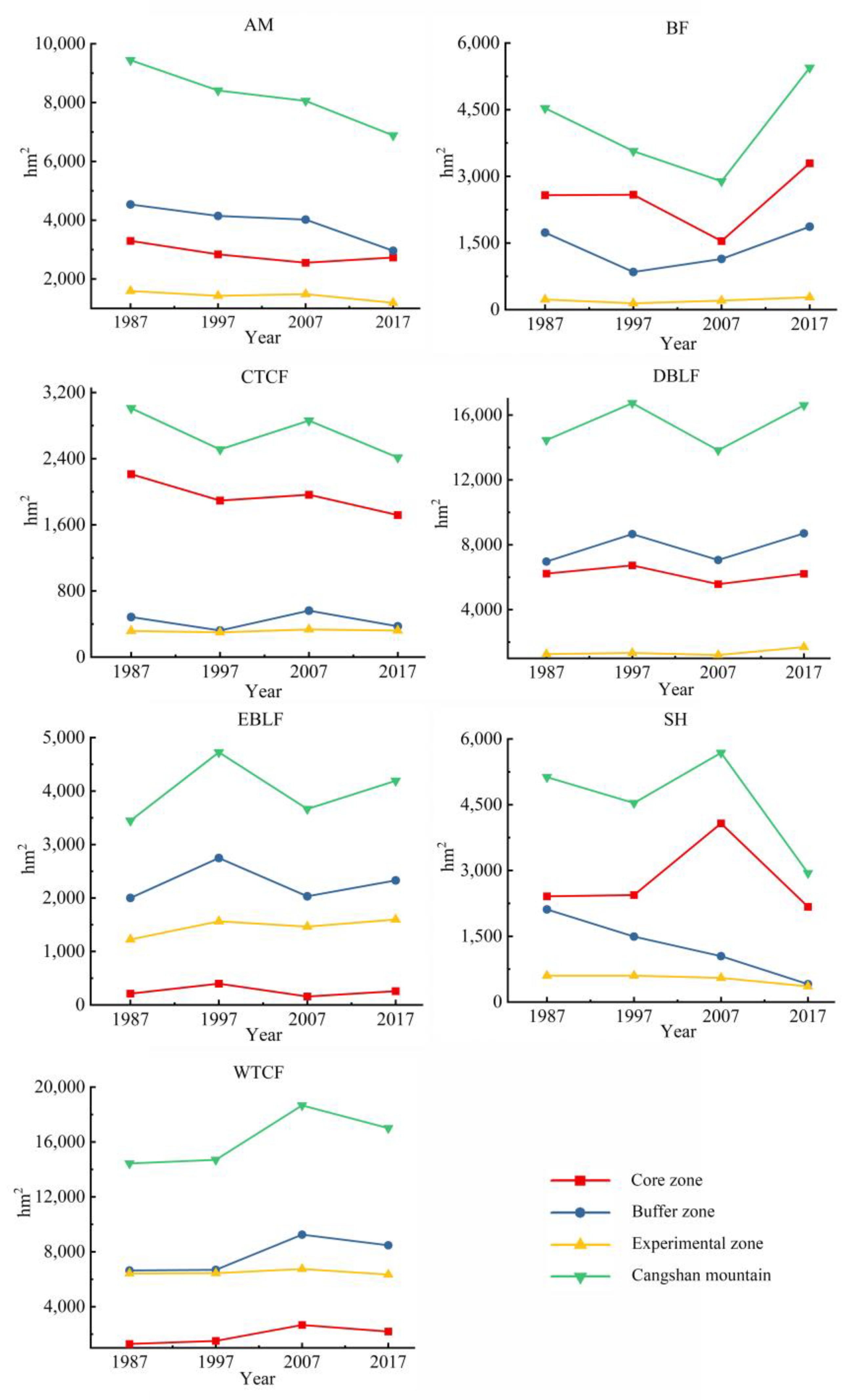

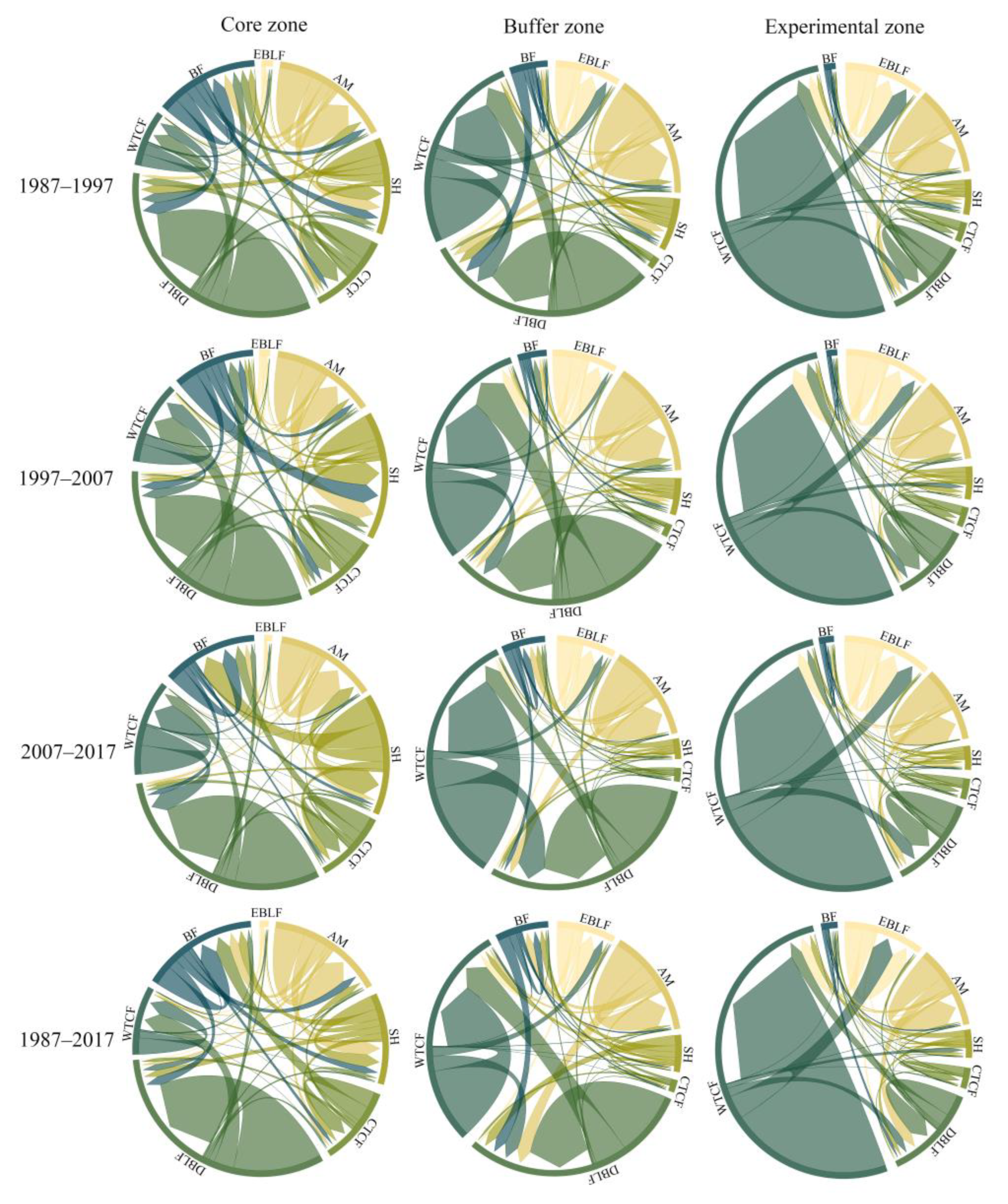
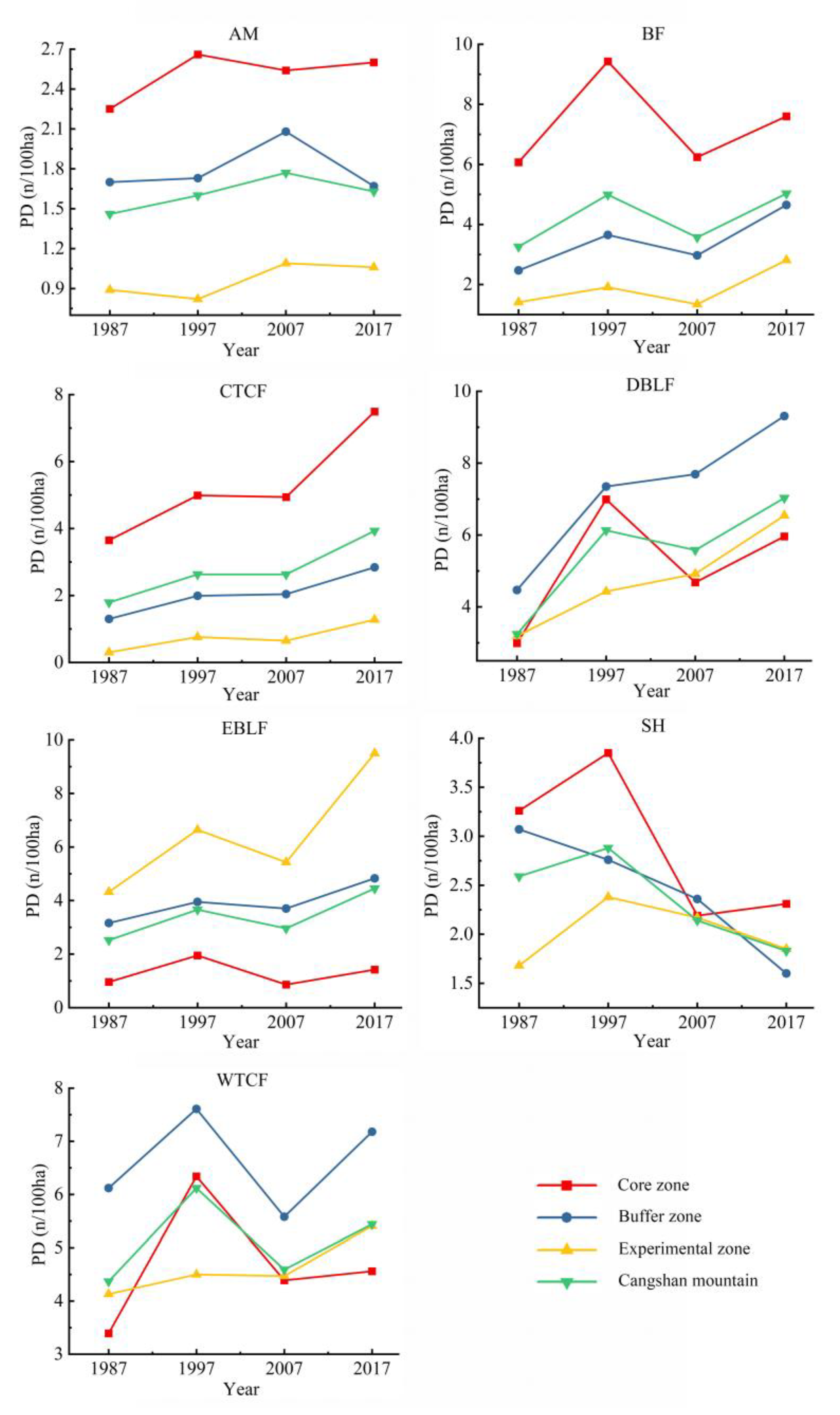

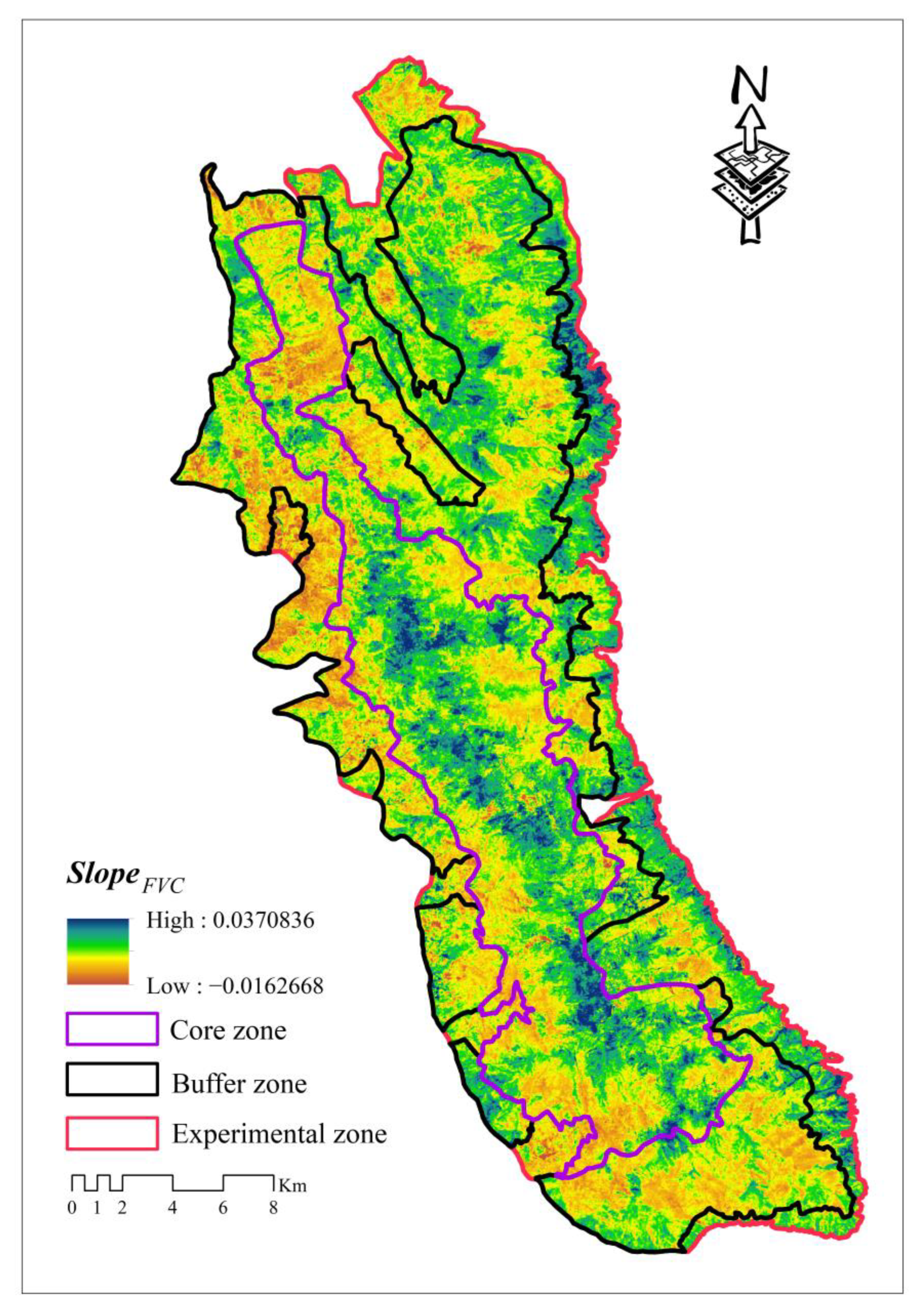

| Indices | Type | Description |
|---|---|---|
| Class area (CA) | Class metrics | CA equals the sum of the areas of all patches of the corresponding patch type [31]. It is a measure of landscape composition; specifically, how much of the landscape is comprised of a particular patch type. |
| Patch density (PD) | Class metrics | PD equals the number of patches of the corresponding patch type divided by total landscape area [31]. An increase in the PD usually indicates an increase in fragmentation. |
| Landscape shape index (LSI) | Landscape metrics | LSI provides a standardized measure of total edge or edge density that adjusts for the size of the landscape [31]. |
| Contagion index (CONTAG) | Landscape metrics | Contagion is inversely related to edge density [31]. When edge density is very low, contagion is high, and vice versa. |
| Shannon’s diversity index (SHDI) | Landscape metrics | SHDI equals minus the sum, across all patch types, of the proportional abundance of each patch type multiplied by that proportion [31]. |
| Periods | 0 ≤ FVC < 0.2 | 0.2 ≤ FVC < 0.4 | 0.4 ≤ FVC < 0.6 | 0.6 ≤ FVC < 0.8 | 0.8 ≤ FVC < 1.0 | |
|---|---|---|---|---|---|---|
| Cangshan mountain | 1987 | 0.00 | 0.02 | 4.87 | 35.44 | 59.67 |
| 1997 | 0.02 | 0.56 | 3.90 | 17.79 | 77.73 | |
| 2007 | 0.13 | 2.61 | 7.93 | 24.15 | 65.18 | |
| 2017 | 0.00 | 0.00 | 0.20 | 1.90 | 97.89 | |
| Core zone | 1987 | 0.00 | 0.07 | 6.15 | 34.83 | 58.95 |
| 1997 | 0.06 | 1.60 | 8.70 | 20.90 | 68.74 | |
| 2007 | 0.33 | 5.34 | 14.52 | 32.29 | 47.52 | |
| 2017 | 0.00 | 0.02 | 0.49 | 3.47 | 96.01 | |
| Buffer zone | 1987 | 0.00 | 0.01 | 3.08 | 31.38 | 65.54 |
| 1997 | 0.00 | 0.08 | 1.38 | 15.40 | 83.13 | |
| 2007 | 0.02 | 1.24 | 4.43 | 20.30 | 74.00 | |
| 2017 | 0.00 | 0.00 | 0.01 | 0.87 | 99.11 | |
| Experimental zone | 1987 | 0.00 | 0.02 | 6.44 | 44.75 | 48.79 |
| 1997 | 0.00 | 0.03 | 2.12 | 19.16 | 78.69 | |
| 2007 | 0.04 | 1.31 | 5.24 | 19.23 | 74.18 | |
| 2017 | 0.00 | 0.00 | 0.16 | 1.73 | 98.11 |
Disclaimer/Publisher’s Note: The statements, opinions and data contained in all publications are solely those of the individual author(s) and contributor(s) and not of MDPI and/or the editor(s). MDPI and/or the editor(s) disclaim responsibility for any injury to people or property resulting from any ideas, methods, instructions or products referred to in the content. |
© 2023 by the authors. Licensee MDPI, Basel, Switzerland. This article is an open access article distributed under the terms and conditions of the Creative Commons Attribution (CC BY) license (https://creativecommons.org/licenses/by/4.0/).
Share and Cite
Ni, C.; Chen, Y.; Hu, X.; Feng, J. Vegetation Change and Conservation Evaluation of the Cangshan Erhai National Nature Reserve (Cangshan Mountain Part) in Southwest China. Forests 2023, 14, 1485. https://doi.org/10.3390/f14071485
Ni C, Chen Y, Hu X, Feng J. Vegetation Change and Conservation Evaluation of the Cangshan Erhai National Nature Reserve (Cangshan Mountain Part) in Southwest China. Forests. 2023; 14(7):1485. https://doi.org/10.3390/f14071485
Chicago/Turabian StyleNi, Chunchen, Youjun Chen, Xiaokang Hu, and Jianmeng Feng. 2023. "Vegetation Change and Conservation Evaluation of the Cangshan Erhai National Nature Reserve (Cangshan Mountain Part) in Southwest China" Forests 14, no. 7: 1485. https://doi.org/10.3390/f14071485
APA StyleNi, C., Chen, Y., Hu, X., & Feng, J. (2023). Vegetation Change and Conservation Evaluation of the Cangshan Erhai National Nature Reserve (Cangshan Mountain Part) in Southwest China. Forests, 14(7), 1485. https://doi.org/10.3390/f14071485






